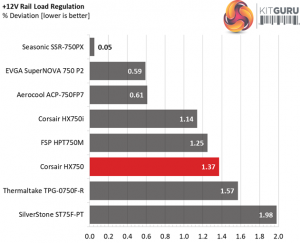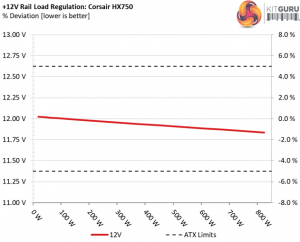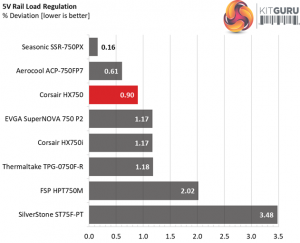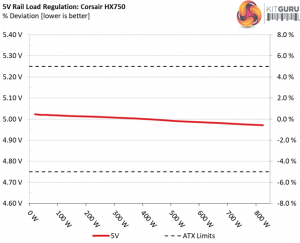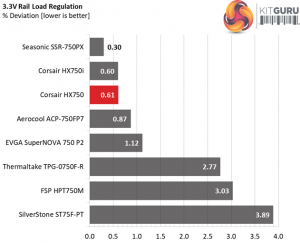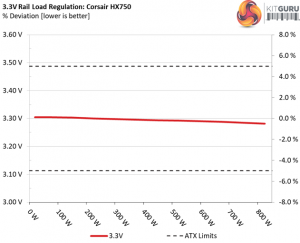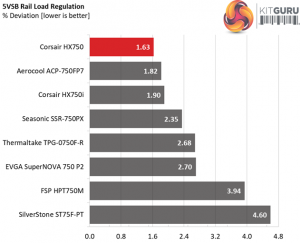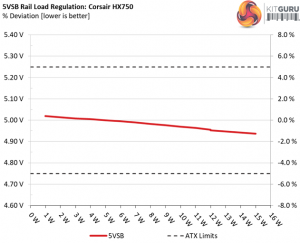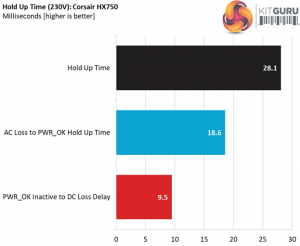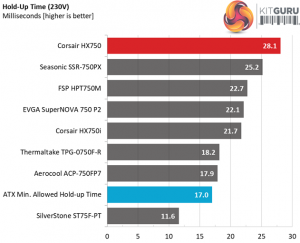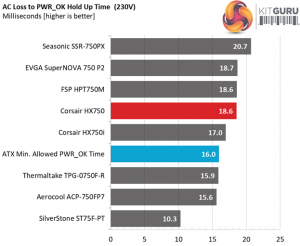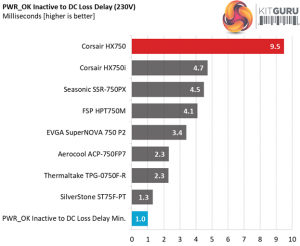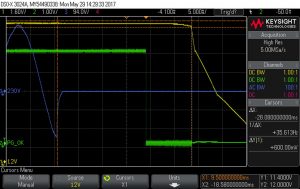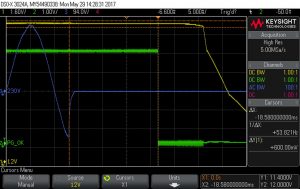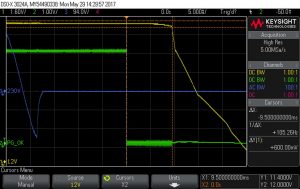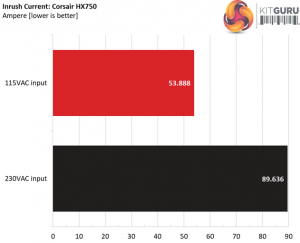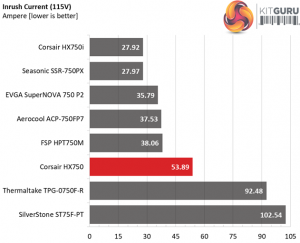To learn more about our PSU tests and methodology, please check out How We Test Power Supply Units.
Primary Rails And 5VSB Load Regulation
Load Regulation testing is detailed here.
Hold-Up Time
Our hold-up time tests are described in detail here.
The oscilloscope screenshots that we took during the hold-up time measurements:
The hold-up time is quite long and the same applies for the period between the power cut and the moment that the PSU informs the mainboard that it needs to shut down, through the power-ok signal.
Inrush Current
For details on our inrush current testing, please click here.
The inrush current is high, with both 115V and 230V input. It might not reach the levels of High Power's platforms, but we would like to see lower readings here.
Load Regulation And Efficiency Measurements
The first set of tests reveals the stability of the voltage rails and the HX750’s efficiency. The applied load equals (approximately) 10 to 110 percent of the power supplies maximum load in increments of 10 percentage points.
We conducted two additional tests.
During the first, we stressed the two minor rails (5V and 3.3V) with a high load, while the load at +12V was only 0.1A. This test reveals whether a power supply is compatible with Intel’s C6/C7 sleep states or not. In the second test, we determined the maximum load the +12V rail could handle with minimal load on the minor rails.
| Test # | 12V | 5V | 3.3V | 5VSB | DC/AC (Watts) | Efficiency | Fan Speed (RPM) | PSU Noise (dB[A]) | Temps (In/Out) | PF/AC Volts |
| 1 | 4.435A | 1.995A | 1.995A | 0.999A | 74.852 | 86.349% | 0 | <6.0 | 46.59°C | 0.966 |
| 12.007V | 5.019V | 3.305V | 5.000V | 86.685 | 38.10°C | 115.14V | ||||
| 2 | 9.920A | 2.988A | 2.993A | 1.201A | 149.811 | 90.650% | 0 | <6.0 | 47.86°C | 0.988 |
| 11.990V | 5.015V | 3.303V | 4.995V | 165.264 | 38.65°C | 115.14V | ||||
| 3 | 15.772A | 3.497A | 3.512A | 1.401A | 224.925 | 91.835% | 0 | <6.0 | 48.58°C | 0.994 |
| 11.972V | 5.011V | 3.300V | 4.989V | 244.924 | 38.86°C | 115.14V | ||||
| 4 | 21.630A | 3.996A | 3.999A | 1.606A | 299.805 | 92.130% | 0 | <6.0 | 50.08°C | 0.995 |
| 11.956V | 5.007V | 3.298V | 4.982V | 325.414 | 39.52°C | 115.13V | ||||
| 5 | 27.166A | 4.990A | 5.003A | 1.805A | 374.718 | 91.934% | 0 | <6.0 | 52.31°C | 0.997 |
| 11.937V | 5.003V | 3.296V | 4.976V | 407.595 | 40.45°C | 115.13V | ||||
| 6 | 32.707A | 6.005A | 6.007A | 2.011A | 449.722 | 91.449% | 710 | 14.7 | 40.92°C | 0.998 |
| 11.922V | 4.997V | 3.294V | 4.970V | 491.774 | 53.36°C | 115.12V | ||||
| 7 | 38.272A | 7.014A | 7.015A | 2.215A | 524.684 | 90.829% | 730 | 13.1 | 41.33°C | 0.998 |
| 11.904V | 4.990V | 3.293V | 4.964V | 577.661 | 54.21°C | 115.12V | ||||
| 8 | 43.849A | 8.027A | 8.023A | 2.420A | 599.645 | 90.271% | 900 | 20.7 | 42.23°C | 0.998 |
| 11.887V | 4.986V | 3.290V | 4.956V | 664.270 | 55.67°C | 115.11V | ||||
| 9 | 49.878A | 8.533A | 8.546A | 2.421A | 674.695 | 89.702% | 1050 | 25.9 | 43.55°C | 0.998 |
| 11.871V | 4.981V | 3.288V | 4.953V | 752.149 | 57.71°C | 115.11V | ||||
| 10 | 55.672A | 9.053A | 9.039A | 3.036A | 749.610 | 89.029% | 1170 | 29.7 | 44.71°C | 0.998 |
| 11.853V | 4.976V | 3.285V | 4.937V | 841.985 | 59.54°C | 115.10V | ||||
| 11 | 62.084A | 9.060A | 9.049A | 3.040A | 824.500 | 88.460% | 1260 | 31.4 | 45.99°C | 0.998 |
| 11.835V | 4.971V | 3.282V | 4.934V | 932.061 | 61.27°C | 115.10V | ||||
| CL1 | 0.100A | 18.026A | 18.002A | 0.005A | 151.066 | 83.694% | 845 | 19.1 | 44.08°C | 0.990 |
| 11.974V | 4.992V | 3.325V | 5.050V | 180.499 | 51.94°C | 115.14V | ||||
| CL2 | 62.457A | 1.004A | 1.004A | 1.002A | 753.774 | 89.514% | 1130 | 28.0 | 44.28°C | 0.998 |
| 11.856V | 4.990V | 3.278V | 4.973V | 842.073 | 52.97°C | 115.11V |
The load regulation at +12V is not the best we have seen, however it isn't bad either. On the minor rails the voltage deviations are lower. When it comes to noise output, the HX750 excels even under tough conditions. Up to the 50% load test the fan remains deactivated and even during the overload test with 110% load, the PSU remains silent enough since it barely exceeds 31 dB(A) noise. Corsair/CWT used a highly relaxed fan profile since this is a highly efficient platform, so the thermal loads are kept load hence there is no need for increased airflow.
With 20% load the 90% mark that the 80 PLUS Platinum standard requires is easily met, while with mid (50%) load the unit is very close to 92%. Finally, with full load the 89% requirement is met, even with 45°C ambient while 80 PLUS performs its evaluations under much lower temperatures (23°C ±5°C).
 KitGuru KitGuru.net – Tech News | Hardware News | Hardware Reviews | IOS | Mobile | Gaming | Graphics Cards
KitGuru KitGuru.net – Tech News | Hardware News | Hardware Reviews | IOS | Mobile | Gaming | Graphics Cards

